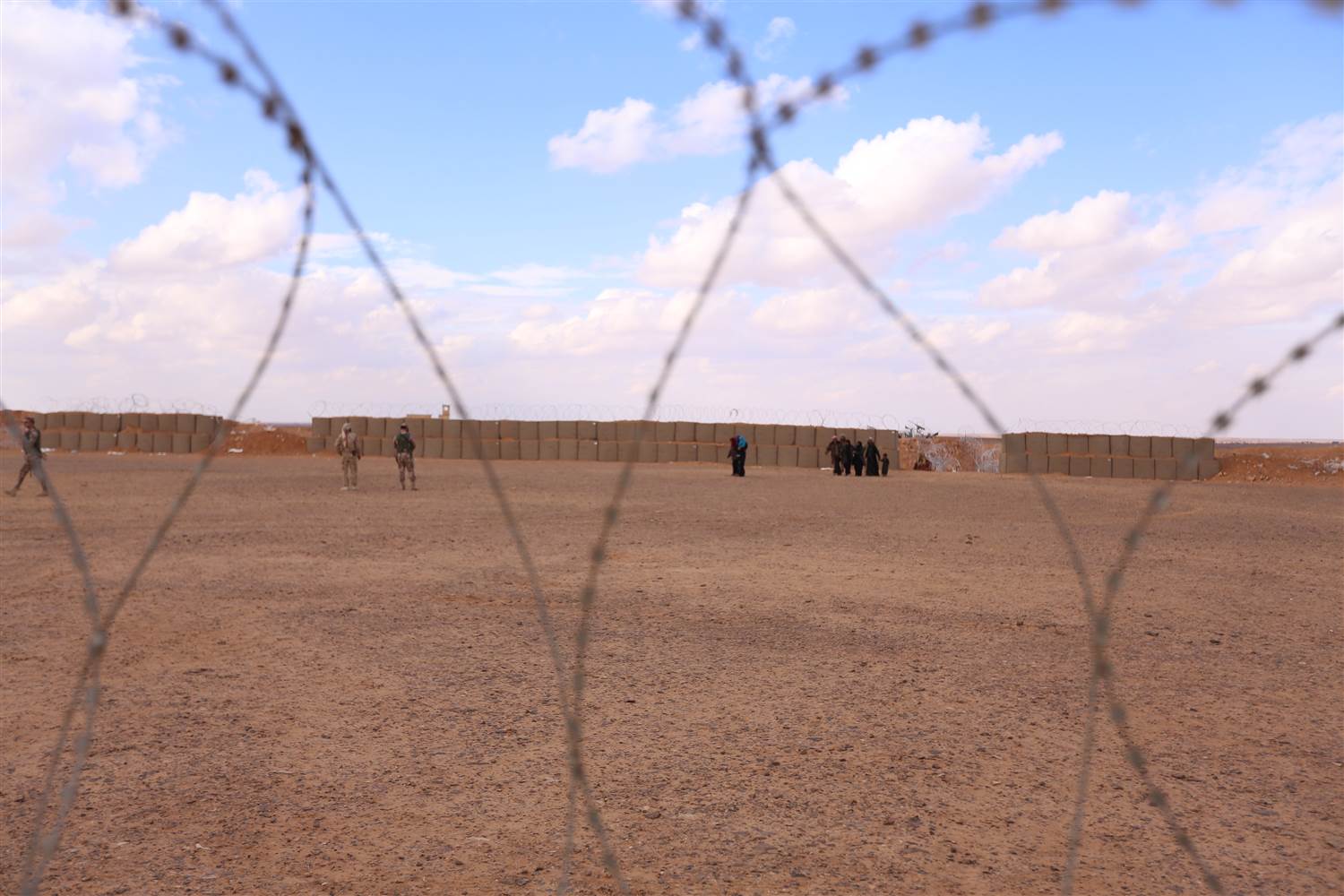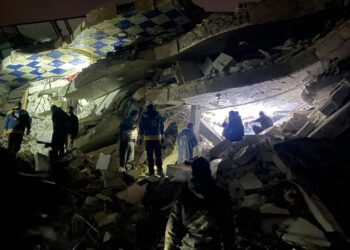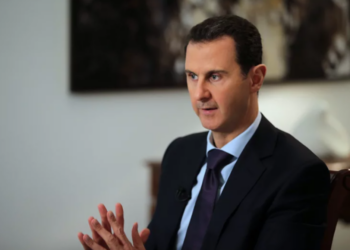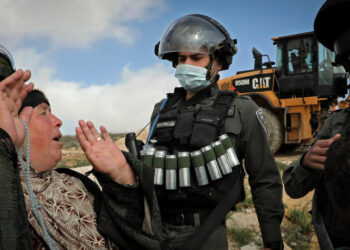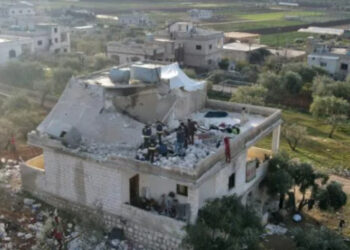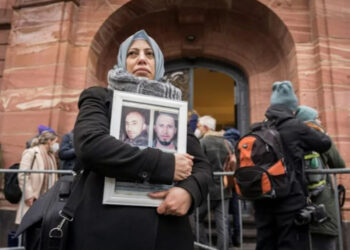AMMAN, Jordan — Life has been devastating for the thousands of displaced Syrians living in Rukban camp, a barren no man’s land on the Jordan-Syria border, where food and water is sparse and lawlessness abounds. This already dire humanitarian situation has been intensified in the last few months, as airstrikes and fighting from Syria’s civil war edges closer towards those trapped along the border.
With Syrian government troops making swift advances against rebel forces in the country’s south-east, Syrians seeking refuge by the Jordanian border are fearful for their lives, existing in a state of “serious distress and panic,” U.N. agencies said in August.
Last month, around five thousand Syrians fled east from Hadalat camp to the relative safety of Rukban, running from shelling and nearby fighting between Syrian rebels and government troops, according to local reports. Hundreds more are reportedly flowing in from Deir ez-Zor, the largest city in eastern Syria where rebel and government forces have launched separate offensives against Islamic State.
However, while Rukban is situated further away from the ongoing ground fighting and airstrikes, the estimated 75,000 residents of the camp remain in a precarious situation as the battle in Syria’s east rages on.
Rukban residents are currently protected from Syrian troops by the Al Tanf military base, which lies 18 kilometers (11 miles) from Rukban and is controlled by U.S. and Coalition forces. The base is used as a facility to train and equip vetted Syrian opposition forces, including the Maghawir al-Thawra (Revolutionary Commando Army). However, the protective presence of the base remains highly unpredictable, with rumors circulating that U.S. forces will be pulled from the base in the near future.
“The rumors have left the women and children of the camp stricken with fear and panic, and they are currently in the process of being verified,” Abu Muhammad Al I’kady, Media Officer in Rukban, said in a statement. “Many of the young men are worried and nervous, fearful of the possibility of the Syrian Regime entering the Rukban Camp, which will, according to the young men, lead to their arrest and enlistment into the Syrian Regime’s army,” he added.
A spokesperson for the U.S.-led Coalition against Islamic State told The Globe Post that “coalition forces continue to conduct patrols out of Al Tanf to train and prepare local forces for counter-ISIS operations,” but would not confirm if or when the base will be closed.
Alongside fears of approaching regime forces, the humanitarian situation in Rukban camp has become unbearable for the thousands of people living on the border. Omar Al Beniai, the spokesperson for the Tadmur and Syrian Badiyyeh tribes in the camp, told local journalists that the situation has only worsened since the influx of residents from Hadalat camp.
One man who fled Hadalat told the Associated Press last month, “If the people here at the Jordanian border don’t die from bombs, they will die from hunger and thirst.”
Access to humanitarian aid has been sparse since Jordan formally closed the border with Syria in 2016, after an Islamic State car bomb at a Rukban military base killed seven Jordanian border guards. There have only been three rounds of aid distributions, with the last one being a partial distribution in June 2011, according to the Jordanian INGO Forum.
Focused primarily on security concerns and tackling extremism, Jordan has distanced itself from humanitarian responsibility to the camp, which is home to a mix of rebel groups and extremist militants among the mostly civilian population. Minister of Foreign and Expatriate Affairs, Ayman Al Safadi, recently told media that the residents of Rukban refugee camp are “Syrian refugees on Syrian lands,” stressing that humanitarian assistance to the displaced residents of the camp must come from Syria.
Denied the right to seek asylum in Jordan, and with meagre assistance, the Rukban population is in urgent need of food, access to clean water, healthcare and shelter ahead of the approaching winter months. Human Rights Watch has reported that the minimal aid available is generally controlled by a Jordanian-backed militia, the Tribal Army, which has taken advantage of the power vacuum within the camp by exerting its own ad hoc sense of rule.
MaT and the Free Syria Army affiliate Jaish Usud al-Shaqiya (Lions of the East) also patrol the camp and nearby border crossing.
“It’s a dog eat dog world in Rukban. There is no law. Theft and corruption are prevalent. Murders happen and no one is held accountable for them,” Bahira al-Zarier, a Syrian analyst working closely with people in Rukban, told The Globe Post.
Within this deteriorating humanitarian context local media have reported that, along with the flow of refugees into Rukban, hundreds are leaving the camp and heading north, opting to risk the unknown dangers in Syria rather than stay on the border.
“Plenty of families have returned to Syria from Rukban. Nearly 4,000 people – 580 families – have returned to Syria,” Ms. Zarier said. “The situation in Rukban is worse, and the people of the camp are afraid of the Syrian regime’s advancement towards the camp.”
However, for the thousands of people pushed up against the Jordanian border, the alternatives for escape are limited; heading back into Syria is to risk falling into the hands of government forces on one hand, and Islamic State and other extremist groups on the other.
Earlier this month, Islamic State recaptured Qaryatayn, in central Homs province, from the Syrian regime, further discouraging many from leaving Rukban camp and making their way home. According to Ms. Zarier, up to three hundred families were preparing a reconciliation deal with the Syrian regime to return to Qaryatayn, but decided to stay in Rukban after Islamic State took control of the city.
Future of Rukban camp in question
With the alternating flows of refugees along the Jordan-Syrian border, coupled with the lack of aid reaching people in Rukban, the future of the camp remains unclear.
The Jordan Times recently reported that the camp is expected to close in the near future, quoting a U.N. official as saying: “The momentum of operation in the camp is declining and interventions by aid agencies are also decreasing… the camp is expected to be removed in the next few months as the number of its resident is shrinking.”
The Globe Post contacted the U.N. Refugee Agency for further comment, but the agency was unable to provide further details on Rukban camp due to the “to the fluid situation” along the border.
However, according to Ms. Zarier, the high number of Syrians living in the area suggest that an imminent closure of the camp is not possible. “How will 75 to 85 thousand people be evacuated in a matter of months?” she asked.
“If safe passage was provided for Rukban residents to head north by the coalition forces, evacuation would be realistic. Otherwise, how will the people leave Rukban?”
So far no plans have been formed to carve out a safe passage for escape, a situation highlighted by the hundreds of families who have chosen to stay in limbo rather than return to rebel or regime-held territory.
Having fled the carnage of Syria’s civil war only to have it catch up to them at the border, most people have no other option but to wait in fear, trapped in Rukban’s wind-battered stretch of no man’s land.


